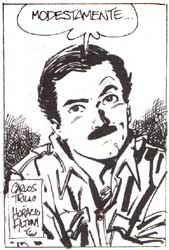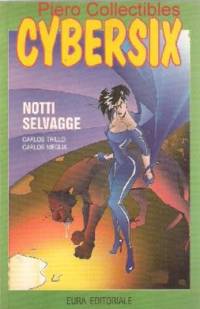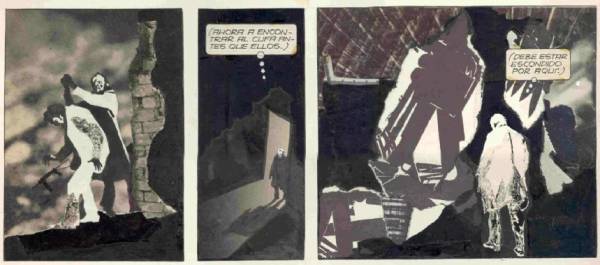 Home > News Story and Obituary Archive
Home > News Story and Obituary Archive Carlos Trillo, 1943-2011
posted June 6, 2011
Carlos Trillo, 1943-2011
posted June 6, 2011

 Carlos Trillo
Carlos Trillo, the versatile Argentinian comics writer who seized an international readership penning stories for some of the finest illustrators in the art form, including many from his country's rigorous comics art tradition, died in London on May 8. He was 68 years old.
Among the prominent artists with whom Trillo worked are Horacio Altuna, Domingo Mandrafina, Peni, Jordi Bernet, Eduardo Risso, Alberto Breccia, Walter Fahrer and Enrique Breccia.
Trillo was born in Buenos Aires in 1943.
He made his professional debut in 1963, penning a story for
Patoruzu and working as a freelance editor for a variety of publishers and publications. Among the features to which Trillo contributed writing work from 1964 to 1968 were
La familia Panconara, una familia muy rara and
El hada Patricia. In 1969, Trillo penned his first significant work about comics, three volumes in a wider cultural series on the specific subject of writing humor.
In the early 1970s, Trillo famously took on art director duties at the satirical magazine
Satiricon (1972-1973). That publication was banned by Argentina's military dictatorship in 1976, although I'm certain it reappeared on stands at a later date. Trillo apparently penned several parodies of other people's work for that publication before and after work was suspended. He also worked on the staff of the publications
Mengano (1974-1976) and
SuperHumor (1981-1982). In 1980, Ediciones Record published what may have been his most significant work about comics, a history of the form focused on the thriving Buenos Aires/Argentinian market:
Historia de la historieta argentina.

By this time, Trillo's writing career was firmly established: he had become a part of the comics history he described in his non-fiction prose. His sphere of influence would grow over the span of three-plus decades, as he became one of the world's most consistent scriptwriters. Trillo wrote the well-received
Un Certain Danari for the legendary Alberto Breccia in 1975, quickly followed in that same calendar year by
Chavez le Fou for Horacio Altuna. He also continued writing for several magazines in a variety of genres, placing work in
El Pendulo and
Superhumor>. Trillo teamed with Altuna on a newspaper strip that became a career highlight,
El Loco Chavez. That ran from 1975 to 1987 in the newspaper
Clarin -- Argentina's most-read newspaper, a politically centrist publication with a massive share of Buenos Aires' collective eyeballs on a daily basis. Glenat collected a portion of that work for the French-language market. A replacement strip,
El Negro Blanco, ran from 1987 until 1993 and featured the artist Ernesto Garcia Seijas. Key to Trillo's work reaching multiple markets was his collaboration with Enrique Breccia
Alvar Mayor, the late '70s, early '80s effort that was republished in Italian, Spanish and French. His album-length collaborations with newspaper strip partner Altuna were also key in establishing a presence in the Spanish market -- Altuna eventually moved there -- and Trillo also placed work in English through
Heavy Metal. A partnership with Jordi Bernet starting in the mid-1980s cemented for Trillo an attentive international audience. Much of Trillo's best-regarded work, which soon included another significant partner, Eduardo Risso, exhibited rock-solid values of their representative genre but added a level of reflective social satire.

In the 1990s, Trillo published
Cybersix with frequent creative partner Carlos Meglia. That series was published as a book series in several languages and in multiple markets starting with Argentina. It was a significant, international sales success. A live-action version of the property bombed, while a later cartoon adaptation was well-received; no matter the fate of any spin-off, the comics were a definite sales highlight for the writer, and, partly as they came in such quick succession, a notable accomplishment for their content.
Trillo was a two-time winner of the Lucca comics festival's Yellow Kid Award for Best International Author (1978, 1996), and won the Salon Internacional del Comic de Barcelona's prize for best writer of the year in 1984. A significant career highlight came in 1999 when Trillo won the writing prize at the Angouleme Festival -- back when Angouleme had a writing prize -- for
La Grande Anarque, an effort with the artist Domingo Mandrafina published in France by L'Echo Des Savanes. In June 2001, a major exposition of his works was given at that year's Napoli Comicon, where Trillo was given the Premio Attilio Micheluzzi as a career honor.
Trillo's work was still being actively published in several markets, including the sometimes difficult-to-penetrate North American comics industry. IDW published his
Chicanos in an eight-issue series in 2005-6, collected into two trades. Another work with artist Risso, the 600-page
Borderline, was turned into a series of trades by Dynamite at around the same time, volumes published and volumes yet to come. Trillo continued to publish with a variety of artists including new partners such as Domingues and Ignacio Noé. Starting in the mid-2000s, Trillo even wrote another serial for
Clarin, called
Hunted, which was illustrated by Alejandro "O'kif" O'Keefe. Trillo continued creating in prolific fashion across several platforms until the time of his passing.
Carlos Trillo is survived by a wife -- the writer
Ema Wolf, with whom he was vacationing at the time of his passing -- and their two children.
*****

*****
*****


